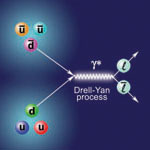Physics
The polarized antiproton − proton interactions at HESR will give a unique access to a number of new fundamental physics observables, which can be studied neither at other facilities nor at HESR without transverse polarization of protons and/or antiprotons:
The transversity distribution is the last leading−twist missing piece of the QCD description of the partonic structure of the nucleon. It describes the quark transverse polarization inside a transversely polarized proton. Unlike the more conventional unpolarized quark distribution q(x,Q2) and the helicity distribution Δq(x,Q2), the transversity h1q (x,Q2) can neither be accessed in deep−inelastic scattering of leptons off nucleons nor can it be reconstructed from the knowledge of q(x,Q2) and Δq(x,Q2). It may contribute to some single−spin observables, but always coupled to other unknown functions. The transversity distribution is directly accessible uniquely via the double transverse spin asymmetry ATT in the Drell−Yan production of lepton pairs. The theoretical expectations for ATT in the Drell−Yan process with transversely polarized antiprotons interacting with a transversely polarized proton target at HESR are in the 30−40 per cent range; with the expected antiproton spin−filtering rate and luminosity of HESR the PAX experiment is uniquely suited for the definitive observation of h1q (x,Q2) of the proton for the valence quarks. The determination of h1q (x,Q2) will open new pathways to the QCD interpretation of single−spin asymmetry (SSA) measurements. In conjunction with the data on SSA from the HERMES collaboration, the PAX measurements of the SSA in Drell−Yan production on polarized protons can for the first time provide a test of the theoretical prediction of the reversal of the sign of the Sivers function from semi−inclusive DIS to Drell−Yan production.
The origin of the unexpected Q2−dependence of the ratio of the magnetic and electric form factors of the proton as observed at the Jefferson laboratory can be clarified by a measurement of their relative phase in the time−like region, which discriminates strongly between the models for the form factor. This phase can only be measured via SSA in the annihilation pbar p↑ → e+e− on a transversely polarized target. The first ever measurement of this phase at PAX will also contribute to the understanding of the onset of the pQCD asymptotics in the time−like region and will serve as a stringent test of dispersion theory approaches to the relationship between the space−like and time−like form factors. The double−spin asymmetry will allow independently the GE−GM separation and serve as a check of the Rosenbluth separation in the time−like region which has not been carried out so far.
Arguably, in pbar p elastic scattering the hard scattering mechanism can be checked beyond |t| = 1/2(s−4mp2) accessible in the t−u−symmetric pp scattering, because in the pbar p case the u−channel exchange contribution can only originate from the strongly suppressed exotic dibaryon exchange. Consequently, in the pbar p case the hard mechanisms can be tested at t almost twice as large as in pp scattering. Even unpolarized large angle pbar p scattering data can shed light on the origin of the intriguing oscillations around the s−10 behavior of the 900 scattering in the pp channel and put stringent constraints on the much disputed odd−charge conjugation Landshoff mechanism. If the Landshoff mechanism is suppressed then the double transverse asymmetry in pbar p scattering is expected to be as large as the one observed in the pp case.
The charge conjugation property allows direct monitoring of the polarization of antiprotons in HESR and the rate of polarization buildup constitutes a direct measurement of the transverse double spin asymmetry in the pbar p total cross section. This asymmetry has never been measured and its knowledge is crucial for the correct extraction of the real part of the forward pbar p scattering amplitude from Coulomb−nuclear interference. The PAX results on the asymmetry will help to clarify the origin of the discrepancy between the dispersion theory calculations and the experimental extraction of the value of the real part of the forward scattering amplitude usually made assuming the spin independence of forward scattering.

 Andrea Pesce
Andrea Pesce